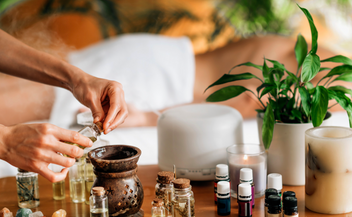Posted by TL Knowledge Team on 3rd Aug 2023
The Therapeutic Power of Terpenes: How They Improve Aromatherapy
The scents of essential oils, carrying you away to tranquil gardens, lush forests, or vibrant citrus groves, are more than just pleasant aromas. They are terpenes: the aromatic compounds lending their unique characteristics to plants and essential oils. More than their enchanting fragrances, terpenes hold the key to the therapeutic benefits of aromatherapy.
The Underlying Role of Terpenes
Terpenes exist naturally within the essential oils of plants, and they serve a vital role in plant survival, acting as a defense mechanism against herbivores, pests, and environmental stresses. But when it comes to aromatherapy, these mighty compounds present a wide range of potential health benefits that can significantly enhance your overall experience.
The therapeutic potential of terpenes hinges on their ability to interact with various receptors and neurotransmitters in the brain. These interactions can influence the release of mood-impacting chemicals such as dopamine and serotonin. As a result, they play a significant role in controlling stress levels, affecting mood, and promoting overall mental wellness.
The Power of Specific Terpenes in Aromatherapy
Delving deeper into specific terpenes, we discover the unique benefits each brings to the world of aromatherapy. For example, let's consider linalool. Predominantly found in lavender but present in over 200 other plant species, linalool is renowned for its calming and relaxing properties. In a study published in the journal Phytotherapy Research, inhalation of linalool reduced stress and anxiety levels, establishing its value as a natural anxiolytic agent.
Then we have pinene, a terpene found in conifer trees and rosemary essential oil. Pinene displays potent anti-inflammatory and antimicrobial properties. According to research in the journal Molecules, pinene can inhibit inflammation and restrict the growth of bacteria and fungi, making it beneficial for respiratory health.
Another powerful terpene in aromatherapy is limonene. With its refreshing citrusy scent found in citrus fruits and peppermint, limonene is associated with elevated mood and stress relief. As per a study in the Journal of Agricultural and Food Chemistry, limonene showcases antidepressant-like effects, demonstrating its potential in managing mood disorders.
Enhancing Aromatherapy with Terpenes
It is widely recognised that terpenes contribute significantly to the therapeutic effects of essential oils. For example, when inhaled or applied topically, essential oils can have direct effects on the body, and terpenes are an essential part of this impact.
One key principle often discussed in relation to terpenes is the "entourage effect." This concept refers to the synergistic interactions between various plant compounds, in which the effects of individual components are enhanced when present together. In the context of aromatherapy, this means that a blend of essential oils can often have a more significant impact than individual oils on their own.
Terpenes also offer a diverse range of individual therapeutic benefits, from anti-inflammatory and antimicrobial effects to mood-enhancing properties. The specific effects depend on the types and concentrations of terpenes within a particular essential oil. As such, understanding the role of terpenes can guide you towards the right essential oils for your needs and help maximize the benefits of your aromatherapy experience.
The world of aromatherapy, as it turns out, goes far beyond mesmerizing fragrances. With terpenes at their core, the therapeutic benefits of essential oils can be fully harnessed. Whether you're seeking a mood lift, stress relief, or improved focus, understanding the role of terpenes can guide you towards the right essential oils and aromatherapy practices.
Next time you indulge in an aromatherapy session, remember that it's not just about the fragrance you're inhaling. It's also about the terpenes working behind the scenes, contributing to your overall well-being.
Discover the power of terpenes in our collection of pure terpenes and aromatherapy oils. Utilise these natural compounds to enhance your aromatherapy experience and enrich your wellness journey. They aren't just captivating aromas; they're hidden heroes with potential health benefits awaiting your exploration.
References
- Buchbauer G. et al., (1991). Aromatherapy: Evidence for Sedative Effects of the Essential Oil of Lavender after Inhalation. Zeitschrift für Naturforschung C. DOI: 10.1515/znc-1991-11-1208
- Russo E. B. (2011). Taming THC: potential cannabis synergy and phytocannabinoid-terpenoid entourage effects. British Journal of Pharmacology. DOI: 10.1111/j.1476-5381.2011.01238.x
- Rahbardar M. G., Amin B., Mehri S., Mirnajafi-Zadeh S. J., Hosseinzadeh H. (2017). Anti-inflammatory effects of ethanolic extract of Rosmarinus officinalis L. and rosmarinic acid in a rat model of neuropathic pain. Biomedicine & Pharmacotherapy. DOI: 10.1016/j.biopha.2017.11.098
- Komori T, Fujiwara R, Tanida M, Nomura J, Yokoyama MM. (1995). Effects of citrus fragrance on immune function and depressive states. Neuroimmunomodulation. DOI: 10.1159/000096889

